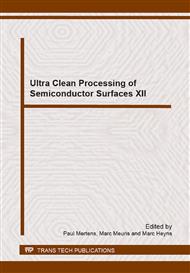p.237
p.241
p.247
p.251
p.256
p.260
p.265
p.268
p.272
Effect of FOUP Atmosphere Control on Process Wafer Integrity in Sub20 nm Device Fabrication
Abstract:
Defects could be generated on the wafers by the particle contamination, formation of organic residue, corrosion, native oxide growth on the surface and airborne molecular contaminants (AMC) [1] etc. These problems hinder the device performance and also can decrease the yield and productivity in the semiconductor manufacturing process. It could be resolved by various cleaning methods [2]. However, the results such as corrosion, native oxide growth on wafer and AMC deposition should be handled properly by N2 gas purge prevention method during the process or standby [3,4]. It should be implemented before starting the process, which can maximize the productivity with a higher yield by minimizing the process queue and maintaining wafer surface integrity in sub 20 nm device fabrication.
Info:
Periodical:
Pages:
256-259
Citation:
Online since:
September 2014
Authors:
Keywords:
Price:
Сopyright:
© 2015 Trans Tech Publications Ltd. All Rights Reserved
Share:
Citation:


